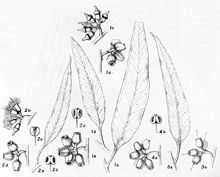Eucalyptus flocktoniae
| Eucalyptus flocktoniae | |
|---|---|
 | |
| Eucalyptus flocktoniae by Margaret Flockton | |
| Scientific classification | |
| Kingdom: | Plantae |
| (unranked): | Angiosperms |
| (unranked): | Eudicots |
| (unranked): | Rosids |
| Order: | Myrtales |
| Family: | Myrtaceae |
| Genus: | Eucalyptus |
| Species: | E. flocktoniae |
| Binomial name | |
| Eucalyptus flocktoniae Maiden | |
Eucalyptus flocktoniae is a species of Australian gum confined to the country's southwest corner near Perth and named after the noted botanical illustrator, Margaret Flockton.
This species was first described in Journ. Roy. Soc. N.S.W. xlix, 316 (1915) and the following description is taken from "A Critical Revision of the Genus Eucalyptus" published by Joseph Henry Maiden (1859-1925) and which is in the public domain.
Seedlings
The seedlings of E. flocktoniae are remarkable, and may thus be described from the earliest stages. Hypocotyl long, wiry and angular, crimson. Cotyledons bisected, green on the back, with sometimes a purple tip. Stem angular, crimson, with prominent oil-glands. First leaves narrow-linear, alternate. They afterwards become opposite. As development proceeds, and while the leaves are opposite, they become decurrent in a remarkable degree. (J.H.M. in Proc. Roy. Soc. N.S.W., xlix, 317.)
Synonyms
E. oleosa F.v.M. var. flocktoniae Maiden in Journ. W.A. Nat. Hist. Soc. iii, 172 (1911); also Part XVI, p. 185, of "A Critical Revision of the Genus Eucalyptus".
Range
So far as is known at present, it is confined to southern parts of Western Australia, from the vicinity of Broome Hill easterly to Esperance, in inland and perhaps coastal situations.
- Esperance (Lindley L. Cowen). Desmond, near Ravensthorpe (J.H.M.).
- Growangerup, 30 miles east of Broome Hill, Great Southern Railway (W. C. Grasby).
Affinities
1. With E. cooperiana F.Muell. Only leaves and flowers (with buds) of E. cooperiana are in existence (see fig. 5, Plate 151, Part XXXVI); fruits were never seen by Mueller, and therefore one must proceed with caution. Some not perfectly ripe fruits (which perhaps belong to E. flocktoniae) have since been attributed to E. cooperiana, but they are, I think, not free from doubt. I hope, therefore, that the publication of the figures (and of the present statement) will set collectors to work, and material will be rendered available to decide what E. cooperiana really is. It is near to E. flocktoniae, from which it differs in the broad peduncles and pedicels, the broader leaves and the operculum, which is long in E. flocktoniae. At the same time, E. cooperiana, and to a less degree E. flocktoniae, are species which require further investigation. Although Mueller said he had not seen E. cooperiana in fruit, I have received from Prof. Ewart a small twig bearing two not fully developed fruits, which certainly bear some general resemblance to those of E. flocktoniae. (Part XXXVI, p. 167.) 2. With E. salmonophloia F.v.M. “Its affinities in this respect (seedlings) are with E. salmonophloia, the young leaves of which are, however, glaucous.” (J.H.M. in Proc. Roy. Soc. N.S.W., xlix, 317, 1915.) 3. With E. gillii Maiden. “It resembles E. gillii in the early stages (seedlings), but the leaves do not then become decurrent.” (J.H.M., ib.) [1][2]